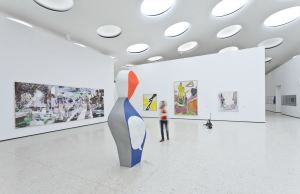Gegenwartskunst in Deutschland
Recently I took a trip to the Northern German city of Düsseldorf to visit a friend who is studying painting at the world renowned Kunstakademie. While there, not only was I able to see the student exhibitions at their annual Rundgang, but I was also exposed to a whole new way of experiencing contemporary art (or gegenwartskunst) at several German museums. I was in awe at the artist’s ability to engage the viewers with their vision as well as how a unique museum space can influence a visitor’s experience of a collection in such a powerful way.

The K21 Ständehaus also known as the Kunst Sammlung Nordrhein Westfalen. Photo Credit: Brittany Wade
I went to several museums while in Düsseldorf, but the one that stuck out the most by a landslide was the K2 Ständehaus. In the now growing urban metropolis of the city, the building itself stands out with its traditional architecture and reflective glass roof. The architecture of the outside of the building has a very stark contrast with its interior, which is a vast open space with corridors filled with contemporary art exhibitions. I was surprised after buying my ticket to be handed a waiver that I had to sign acknowledging the physical danger of one of the installations. I had no idea what this would entail. Had I looked up at the ceiling, I would have fully understood. This was the amazing installation by Argentinian artist Tomás Saraceno called In Orbit; a construction of steel nets and half a dozen floating orbs suspended from the glass canopy roof of the museum.

Tomás Saraceno’s in orbit installation at the K21 Ständehaus. Photo Credit: kunstsammlung.de
This was not only an installation to be seen, it was one to be experienced. We were able to put on fitted jumpsuits and boots and enter the piece to move freely between three levels of netting. If more than one person enters the bold design, an oscillating network of relationships, resonances, and synchronous communication would vibrate throughout the structure. Saraceno had studied the intricacy of spiderwebs for decades and created this piece to move with the same elasticity as insects moving on a web. This is a rare art form that directly evokes certain emotions from its visitors, entangling both fear and excitement; evoking floating, flying, and falling all at once. Pillows had been thrown on to the netting as well so while taking a break from dancing around like a child on a trampoline, you could lounge about, cradled as if on a giant hammock or floating on a cloud. It was one of the most unusual experiences I have had with art in my life.

Newest addition to the Städel Museum; green roof dome garden. Photo Credit: Norbert Miguletz
On a day trip down the Rhein River to Frankfurt, we stopped at the famous Städel Museum. This museum had such a unique space, that it rendered the contemporary art gallery itself into a masterpiece. After three years of renovations and expansions, the Städel Museum reopened with the star of the renovation being its new contemporary gallery located in the courtyard, and topped with a bulging green roof. The garden/roof is dotted with huge round skylights that flood the subterranean gallery with loads of natural light. Not only is the design aesthetically pleasing from above and below, but it is also highly environmentally friendly and energy-efficient.

One of my favorite pieces in the Städel gallery by Maria Lassnig. Photo Credit: Brittany Wade
The contemporary art gallery itself is enormous and slightly intimidating. It almost feels like a labyrinth with room upon room unfolding from one to the next. I even found myself lost at times, but in the most pleasant way; stumbling upon greats like Pablo Picasso and Francis Bacon while finding new favorites of mine like Blinky Palermo and Gerhard Richter. It houses works from 1945 onwards and represents a variety of media from painting, sculpture to photography. Städel Museum exemplifies the diversity of contemporary art with its collection and even within its architectural space.
I most certainly plan on making my way around Germany someday to see what the rest of the country has to offer in terms of its museums and art, because from what I have already seen, I am extremely impressed.

Brittany Wade is the editor of the Initiative for Heritage Conservancy blog and student of the MA in Heritage Management 2013. Having studied Classics in her undergraduate, Brittany is interested in applying her knowledge of history in the field of archaeology. Her interests are mainly in Prehistoric Minoan and Hellenic history.

